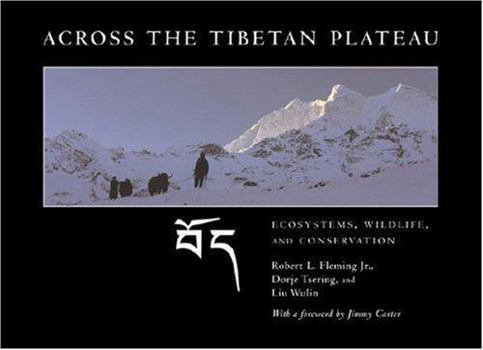Across the Tibetan Plateau: Ecosystems, Wildlife, & Conservation
Here is the most comprehensive photography to date of a little-known and seldom-visited land whose area equals western Europe. The beauty and diversity of Tibet is staggering: from Mount Everest to the world's deepest gorge, from tropical jungles to arctic-like tundra, from trees twenty feet in diameter to vast herds and solitary specimens of some of the least-known animals on the planet. Certain photographs, such as those of a newborn Tibetan antelope or the elusive red ghoral, are among the first ever taken of these subjects. The book brings American, Tibetan, and Chinese scholarship to bear on the natural history of Tibet, and it also describes an extraordinary conservation accomplishment that has gone virtually unnoticed by the outside world. Where else has 40 percent of the land been set aside in nature preserves in twenty years? As a result of this effort, the animals and landscapes shown here will be saved for future generations.
Format:Hardcover
Language:English
ISBN:0393061175
ISBN13:9780393061178
Release Date:October 2006
Publisher:W. W. Norton & Company
Length:120 Pages
Weight:2.95 lbs.
Dimensions:0.7" x 14.1" x 10.3"
Related Subjects
Asia Biological Sciences China Conservation Ecology Ecotourism General Nature Nature & Ecology Photo EssaysCustomer Reviews
2 ratings
Gorgeous photographs and great information on Tibetan wildlife
Published by Thriftbooks.com User , 15 years ago
_Across the Tibetan Plateau_ by Robert L. Fleming Jr., Dorje Tsering, and Liu Wulin is a gorgeous coffee-table book containing excellent photographs, wonderful satellite maps of Tibet, and excellent information on the fauna, flora, climate, and geology of the region. The introductory chapter is very brief, the authors basically making the point that Tibet is often portrayed as a "relentlessly cold plateau of no trees," a land of little other than "windblown yaks and picturesque nomads." They write that it is so much more, a land that includes ecological zones from arctic to subtropic. Chapter one is titled "ferns & firs: the wet southeast." This land is often quite isolated and boasts a subtropical climate and at higher elevations, cold-temperate and mountain-tundra zones. Its chief native human inhabitants being the Monba or Loba people (who cultivate barley and hunt and gather forest products with the use of hunting dogs), the area is botanically diverse, its flora includes often huge cinnamon trees (reaching upwards of 60 feet in height) and over 200 species of rhododendron. Its fauna includes cobras, the red ghoral (a small "goat-antelope"), the giant flying squirrel, the takin ("its face a peculiar profile reminiscent of its closest relative, the musk ox"), and several species of pheasant. The second chapter looks at the rain-shadow deserts of south central Tibet, which on satellite maps appear as "light tan terrain" to the north of the "white-mantled Great Himalayan Range." This land, the "historical heart" of Tibet, includes the traditional birthplace of the Tibetan people (according to legend the result of a union between an ogress and a monkey), the capital Lhasa, impressive avifauna (the Tibetan snow cock, golden eagles, and the Himalayan griffon), and the thankfully increasing blue sheep, the quintessential herbivore of the mountainous highlands of central Asia. Chapter three focuses on the "far west," a land that while on maps appears to be dominated by twin lakes of Manasarowar and Rakshas Tal, is still a rain-shadow desert. In this part of Tibet one finds Mount Kailash, the world's most sacred peak, the bar-headed goose (a small but distinctive goose that nests on the shores of highland lakes throughout Central Asia, it has a physiology such that it can migrate even over the Himalayas), the kiang (or Tibetan wild ass, once quite common), and great herds of domestic yak, vital to the lives of highland pastoralists. Chapter four, "wild yaks & turquoise lakes," looked at the north of Tibet, a land of vast, open vistas and many lakes, some freshwater, some alkaline (nearly five hundred lakes of at least one square kilometer in size exist here). Much of the area is technically tundra with permafrost, resulting in widespread boggy wetlands in the summer months (attracting nesting migratory shorebirds). This region is the last stronghold of the wild yak and the highly endangered Tibetan antelope, overhunted to produce sh
Tibetan Plateau
Published by Thriftbooks.com User , 15 years ago
The pictures in the book were outstanding, and the text was well organized, allowing the reader to find the particular areas of interest. The description of the animals and plants was great, but there was not so much information on conservation activities. Perhaps there isn't too much of that going on. Lovely coffee table book.






